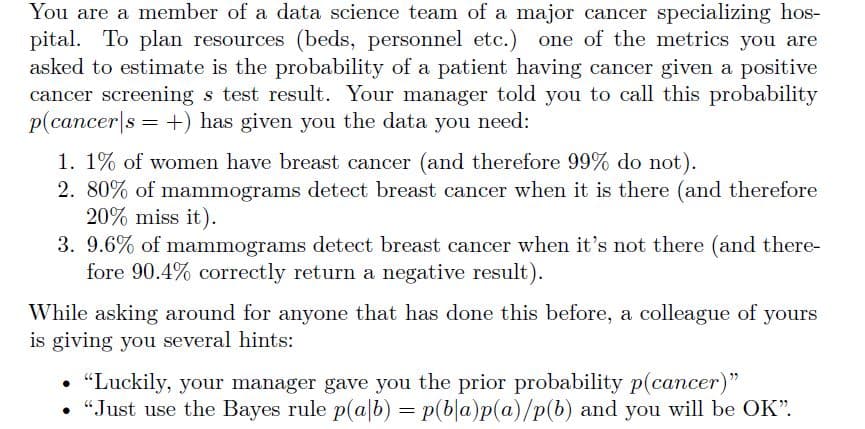You are a member of a data science team of a major cancer specializing hos- pital. To plan resources (beds, personnel etc.) one of the metrics you are asked to estimate is the probability of a patient having cancer given a positive cancer screenings test result. Your manager told you to call this probability p(cancers+) has given you the data you need: 1. 1% of women have breast cancer (and therefore 99% do not). 2. 80% of mammograms detect breast cancer when it is there (and therefore 20% miss it). 3. 9.6% of mammograms detect breast cancer when it's not there (and there- fore 90.4% correctly return a negative result). While asking around for anyone that has done this before, a colleague of yours is giving you several hints: "Luckily, your manager gave you the prior probability p(cancer)" • "Just use the Bayes rule p(ab) = p(ba)p(a)/p(b) and you will be OK".
You are a member of a data science team of a major cancer specializing hos- pital. To plan resources (beds, personnel etc.) one of the metrics you are asked to estimate is the probability of a patient having cancer given a positive cancer screenings test result. Your manager told you to call this probability p(cancers+) has given you the data you need: 1. 1% of women have breast cancer (and therefore 99% do not). 2. 80% of mammograms detect breast cancer when it is there (and therefore 20% miss it). 3. 9.6% of mammograms detect breast cancer when it's not there (and there- fore 90.4% correctly return a negative result). While asking around for anyone that has done this before, a colleague of yours is giving you several hints: "Luckily, your manager gave you the prior probability p(cancer)" • "Just use the Bayes rule p(ab) = p(ba)p(a)/p(b) and you will be OK".
College Algebra
7th Edition
ISBN:9781305115545
Author:James Stewart, Lothar Redlin, Saleem Watson
Publisher:James Stewart, Lothar Redlin, Saleem Watson
Chapter9: Counting And Probability
Section: Chapter Questions
Problem 14T: An unbalanced coin is weighted so that the probability of heads is 0.55. The coin is tossed ten...
Related questions
Question
Please Help ASAP!!!

Transcribed Image Text:You are a member of a data science team of a major cancer specializing hos-
pital. To plan resources (beds, personnel etc.) one of the metrics you are
asked to estimate is the probability of a patient having cancer given a positive
cancer screening s test result. Your manager told you to call this probability
p(cancers+) has given you the data you need:
1. 1% of women have breast cancer (and therefore 99% do not).
2. 80% of mammograms detect breast cancer when it is there (and therefore
20% miss it).
3. 9.6% of mammograms detect breast cancer when it's not there (and there-
fore 90.4% correctly return a negative result).
While asking around for anyone that has done this before, a colleague of yours
is giving you several hints:
"Luckily, your manager gave you the prior probability p(cancer)"
• "Just use the Bayes rule p(ab) = p(ba)p(a)/p(b) and you will be OK".
Expert Solution
This question has been solved!
Explore an expertly crafted, step-by-step solution for a thorough understanding of key concepts.
Step by step
Solved in 2 steps with 2 images

Recommended textbooks for you

College Algebra
Algebra
ISBN:
9781305115545
Author:
James Stewart, Lothar Redlin, Saleem Watson
Publisher:
Cengage Learning


Algebra & Trigonometry with Analytic Geometry
Algebra
ISBN:
9781133382119
Author:
Swokowski
Publisher:
Cengage

College Algebra
Algebra
ISBN:
9781305115545
Author:
James Stewart, Lothar Redlin, Saleem Watson
Publisher:
Cengage Learning


Algebra & Trigonometry with Analytic Geometry
Algebra
ISBN:
9781133382119
Author:
Swokowski
Publisher:
Cengage
